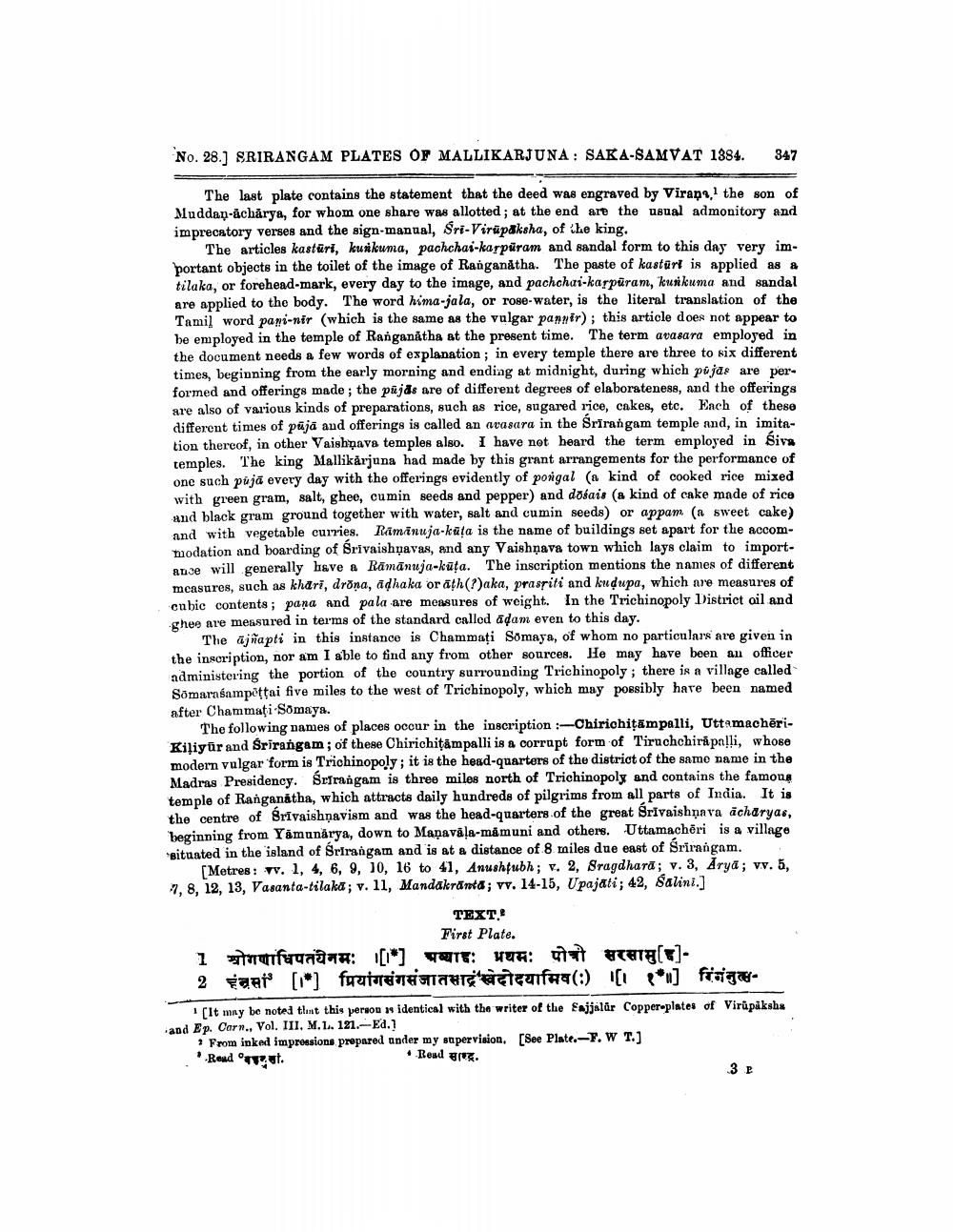________________
No. 28.1 SRIRANGAM PLATES OF MALLIKARJUNA: SAKA-SAMVAT 1884.
347
The last plate contains the statement that the deed was engraved by Virana, the son of Muddan-acharya, for whom one share was allotted ; at the end are the usual admonitory and imprecatory verses and the sign-manual, Sri-Virupaksha, of ke king.
The articles kastüri, kurkuma, pachchai-karpuram and sandal form to this day very important objects in the toilet of the image of Ranganatha. The paste of kastürt is applied as a tilaka, or forehead-mark, every day to the image, and pachchai-karpuram, "kurikuma and sandal are applied to the body. The word hima-jala, or rose-water, is the literal translation of the Tamil word pami-nir (which is the same as the valgar pannir); this article does not appear to be employed in the temple of Ranganátha at the present time. The term avasara employed in the document needs a few words of explanation ; in every temple there are three to six different times, beginning from the early morning and ending at midnight, during which pūjas are performed and offerings made; the pūjds are of different degrees of elaborateness, and the offerings are also of various kinds of preparations, such as rice, sugared rice, cakes, etc. Each of these different times of pājā and offerings is called an avasara in the Srirangam temple and, in imitation thereof, in other Vaishnava temples also. I have not heard the term employed in Siva temples. The king Mallikarjuna had made by this grant arrangements for the performance of one such pūjā every day with the offerings evidently of pongal (a kind of cooked rice mixed with green gram, salt, ghee, cumin seeds and pepper) and došais (a kind of cake made of rice and black gram ground together with water, salt and cumin seeds) or appam (a sweet cake) and with vegetable curries. Ramanuja-kūta is the name of buildings set apart for the accommodation and boarding of Srīvaishṇavas, and any Vaishnava town which lays claim to importanse will generally have a Rāmānuja-kūta. The inscription mentions the names of different measures, such as khari, drona, adhaka or āth(?)aka, prassiti and kudupa, which are measures of cubic contents; para and pala are measures of weight. In the Trichinopoly District oil and ghee are measured in terms of the standard called adam even to this day.
The ājñapti in this instance is Chammați Somaya, of whom no particulars are given in the inscription, nor am I able to find any from other sources. He may have been an officer administering the portion of the country surrounding Trichinopoly, there is a village called Somarnsampētai five miles to the west of Trichinopoly, which may possibly have been named after Chammaţi-Somaya.
The following names of places occur in the inscription :--Chirichiţampalli, UttamachēriKiliyür and Srirangam ; of these Chirichițämpalli is a corrapt form of Tiruchchirapalli, whose modern vulgar form is Trichinopoly; it is the head-quarters of the district of the same name in the Madras Presidency. Srirangam is three miles north of Trichinopoly and contains the famons temple of Ranganatha, which attracts daily hundreds of pilgrims from all parts of India. It is the centre of Srivaishņavism and was the head-quarters of the great Srivaishnava acharyas, beginning from Yamunarya, down to Manavala-mämuni and others. Uttamachëri is a village situated in the island of Srirangam and is at a distance of 8 miles due east of Srirangam.
[Metres: vv. 1, 4, 6, 9, 10, 16 to 41, Anushfubh; v. 2, Sragdhara; v. 3, Arya; vv. 5, 7.8. 12. 13. Vasanta-tilaka ; v. 11, Mandakrāntd; vv. 14-15, Upajati; 42, Salini.]
TEXT.
First Plate. 1 wrofurinn: [*] Watt: : t rex]2 gaat [1*) foutrea c cufa (:) [1 p*u] fisiju
[It may be noted that this person as identical with the writer of the Eajjalar Copper-plates of Virupaksha and Ep. Carn., Vol. III. M. L. 121.-Ed.?
From inked impressions prepared under my supervision. (See Plate.-T. W T.] Reud avat.
. Read




